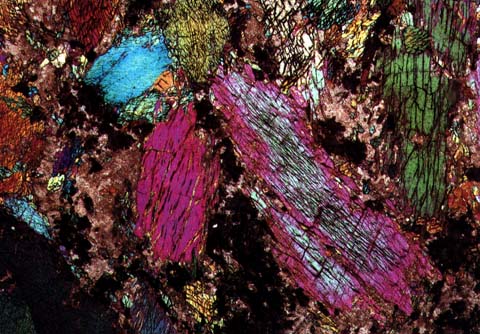
3. RODEL AMPHIBOLITES
Lithology: A variety of amphibolites is exposed in the Rodel area, including garnet-amphibolites, plagioclase amphibolites and hornblendites.
The garnet amphibolites, in hand specimen, consist of a blackish green hornblende and a red garnet, with very few other minerals. The proportion of garnet varies but the grain size ia generally fairly constant, with hornblendes up to 1cm long. Garnets are usually about 1cm square. There may be a vague colour banding which becomes more obvious with an increase in plagioclase content.
The plagioclase amphibolites, in hand specimen, are well-foliated gneisses consisting dominantly of hornblende and plagioclase. The hornblendes have a parallel orientation and grain size is relatively fine (up to 1mm). Microscopic examination of a rock of this type showed it to consist of 51% hornblende, 44% altered plagioclase, 4% opaque minerals (mostly graphite probably) and the remainder mostly quartz. The graphite occurs as streaks in hornblende and the plagioclase is almost completely altered to fine-grained scapolite. This specimen was collected near the north east corner of the Rodel Hotel garden wall. The hornblendites are coarse-grained blackish green rocks consisting almost entirely of hornblende, with only minor garnet.

Photomicrograph of a plagioclase amphibolite from South Harris (c) National Museums of Scotland
Distribution of types: Garnet amphibolites are well exposed in a continuous cliff section on the eastern shore of Loch Rodel, where they are interbanded with both metasediments and plagioclase amphibolites, but are rather scarce elsewhere in the area, though rocks of this type do occur as lenses in the rocks of the igneous complex. They grade into plagioclase amphibolites through a biotite-rich variety. The plagioclase amphibolites are exposed in the cliff section mentioned above and also to the east of this, but are relatively rare in the Rodel area. Hornblendites occur close to the assumed contact of the amphibolite belt of the Loch Rodel cliff section area, with the bulk of the Rodel metasediments in a quarry 300 yards north north west of Rodel Hotel and immediately south of the artificial loch at Rodel schoolhouse. Exposure is relatively poor in this area, however, due to buildings and vegetation and the relationships of the hornblendites to the other members of this series can only be postulated.
Age and Origin: The foliation of these rocks has approximately the same strike (126°- 306°) as the metasediments to the north east and thus must pre-date the deformation producing this foliation (which is a parallel mineral orientation). Their relationship to the metasediments is less clear, however.
Jehu and Craig (1927) suggested that the basic rocks within the Rodel Metasedimentary belt represented lavas and tuffs interbedded with the sediments, whereas Davidson (1943, p.87) considered that most, if not all, of these basic rocks could be regarded as "sills contemporaneous with the anorthosite-metagabbro-eclogite (etc) complex to the north".
Probably some of the amphibolites within the metasedimentary belt, for example the Loch Rodel ones, represent lava flows or tuffs more or less contemporaneous with sedimentation, for there are outcrops of metasediments within the amphibolites. However, the composition of these rocks was probably similar to that of the 'igneous complex' (as shown by the lenses of garnet amphibolite in the garnet — pyroxene - feldsar gneisses to the NNW of Loch na Cachlaidh). This feature may be coincidental, considering the probable length of breaks in the succession in this area (see Part IV).